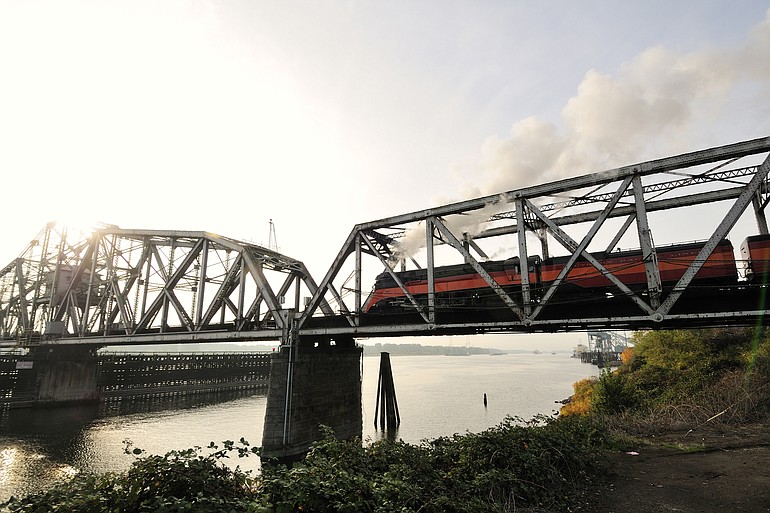Near the top of the list of reasons to replace the Interstate 5 Bridge is the need to halt traffic on the West Coast’s major north-south thoroughfare for boats.
“They’re the last drawbridges on a main line interstate, to my knowledge, anywhere in the country,” said Austin Pratt, bridge administrator for the U.S. Coast Guard district headquartered in Seattle.
Yet, eight years ago federal officials rejected an idea that would have eliminated many bridge lifts for a fraction of the cost of the taller I-5 bridge now being proposed.
On average, the twin spans on I-5 across the Columbia River are lifted roughly once a day to allow commercial barges or tall sailboats to pass safely along their way.
Although an agreement with the Coast Guard precludes bridge lifts during weekday rush hours, a 15-minute shutdown on I-5 can result in miles-long backups and thousands of irritated motorists. Four weeks ago, one such bridge lift just before the morning rush hour snarled southbound traffic into Portland for three hours.
However, if you’re a towboat operator or the U.S. Coast Guard, the system works just fine.
Here’s the rub: During most times of the year for most boats, the mid-point of the Interstate 5 bridge is high enough above the river to allow boats to pass without having to stop freeway traffic.
“If that channel was aligned, and if the bridge had sufficient clearance, I don’t see why it would ever open,” said John Pigott, assistant to the president of Tidewater Barge Lines in Vancouver.
The problem is, the preferred shipping channel is not aligned.
Less than a mile downriver, a century-old railroad bridge stands as a year-round obstacle to barges and the boats propelling them. To get through, towboat operators passing through the high point of the I-5 bridge must angle sharply toward a turn-of-the-century swing span on the BNSF Railway bridge that happens to be along the north bank of the Columbia.
That might be OK for towboats headed upstream, where the river’s current keeps them from going too fast.
But heavily laden barges don’t turn on a dime, especially when they’re headed downstream with the current — and especially when the river’s flowing swiftly.
“A lot of people don’t realize that about barge traffic in the river,” said Tom Warne, a transportation expert who is chairing a panel of experts reviewing plans for a new I-5 bridge. “It’s not like driving your skiff for fishing or your waterskiing boat. They’re not responsive like the boats most people are dealing with.”
Rather than risking a dangerous pileup with the railroad bridge, the Coast Guard and towboat operators prefer to avoid zigzagging between bridges during dicey conditions. And holding a relatively straight line between I-5 and the railroad bridge requires a freeway bridge lift near the north bank of the river.
The new I-5 bridge, now estimated to cost between $600 million and $818 million, would be tall enough to allow boats to pass unfettered.
Controversy continues to swirl over the cost and design of the entire $3.6 billion CRC project, which won’t be finished until 2018 at the earliest. In the meantime, there is another alternative to improving river navigation: Modifying the railroad bridge with a lift span that lines up with the tall portion of the I-5 bridge in the middle of the river.
Eight years ago, the Coast Guard considered doing just that for a fraction of the cost of a new I-5 bridge.
Modifying the railroad bridge with a lift span in the middle of the river would have cost $42 million at the time it was analyzed in late 2002, Pratt said. Under the Truman-Hobbs Act of 1940, the Coast Guard has the authority to underwrite repairs for railroad bridges considered obstructions to navigation.
The skill of towboat operators actually worked against the proposal.
“The cost-benefit ratio simply wasn’t there,” Pratt said. “Towboaters actually do have a good record of zigzagging through those bridges.”
Federal law does not allow the time sacrificed by motorists stranded on I-5 to factor into the Coast Guard’s cost-benefit calculation, Pratt said.
“The openings on the I-5 bridge would probably decrease if that rail bridge improvement happened, but we can’t compute it,” he said. “(The law) absolutely doesn’t allow computation about anything except the effect on navigation. When the CRC came into the picture, here was an opportunity to alleviate the problem without pursuing Truman-Hobbs in the first place.”



